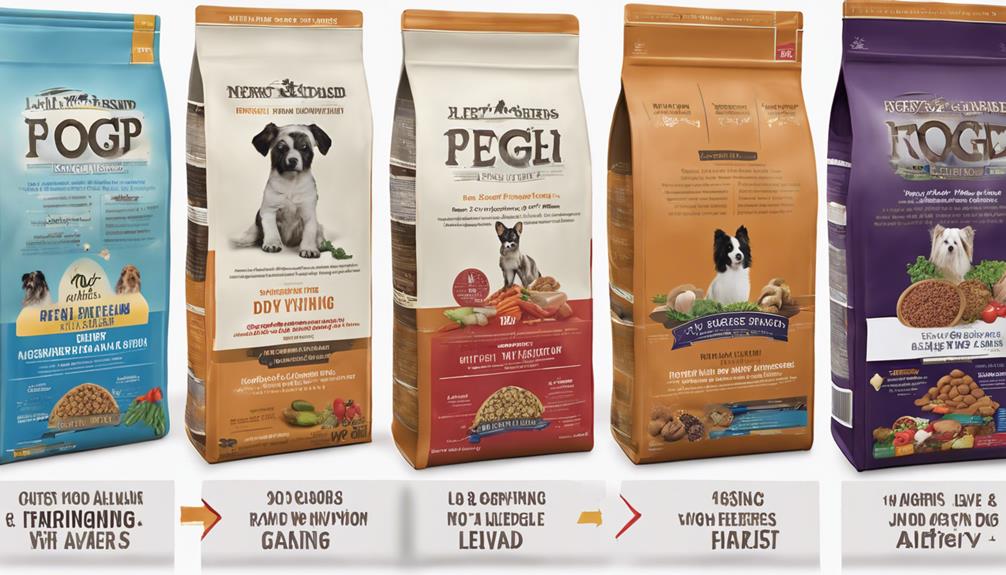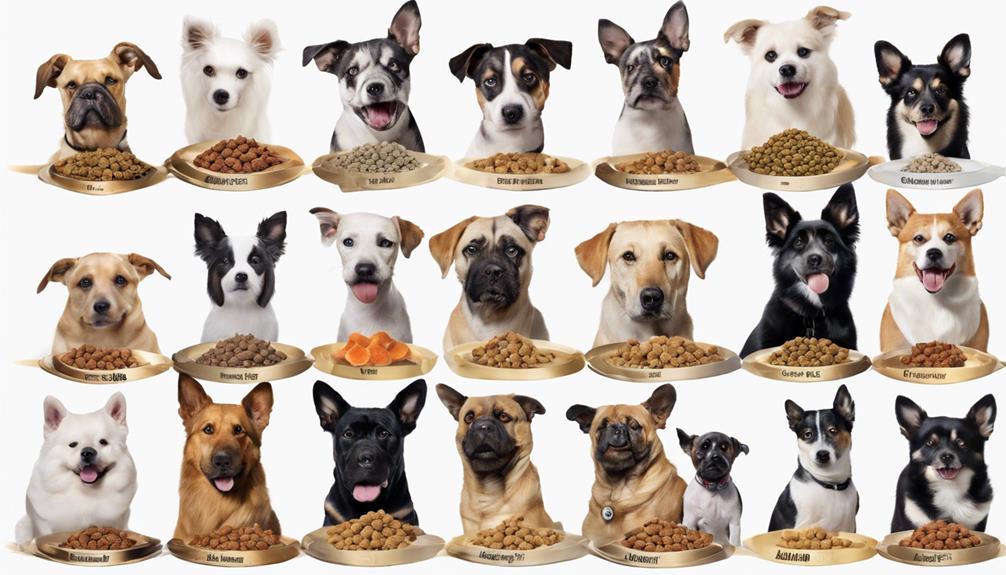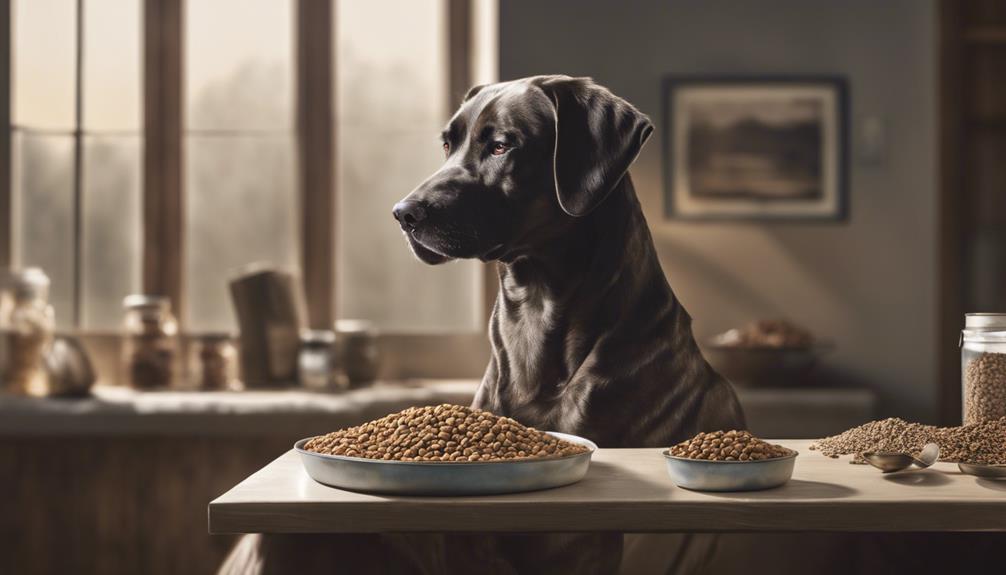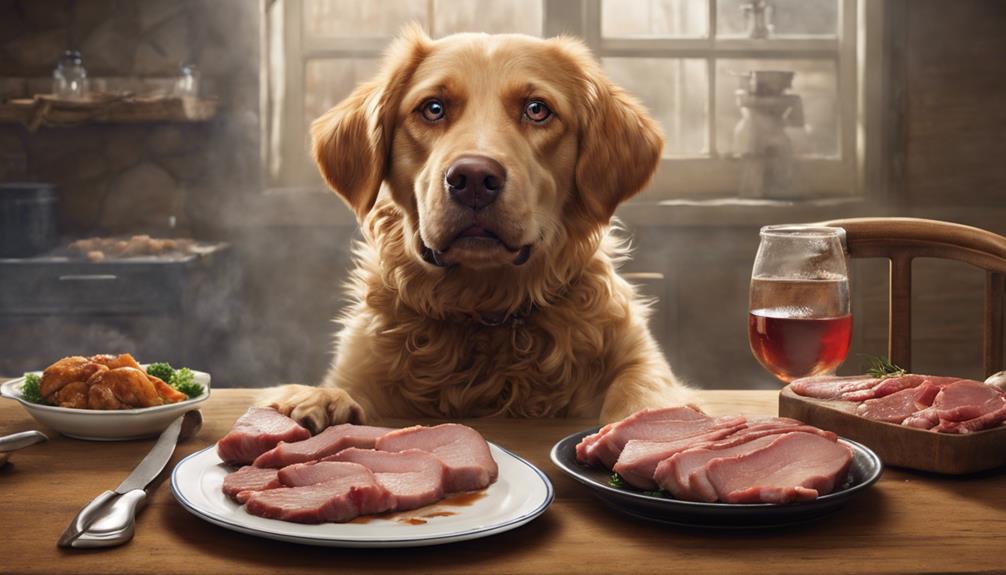When choosing dog food, it is essential to consider factors like age, breed, size, activity level, dietary needs, health conditions, personal preferences, and budget constraints. Life stage plays a role in determining the protein and calorie requirements, while breed characteristics affect specific dietary needs. Adjusting portion sizes, monitoring digestion, addressing health issues, and accommodating preferences are all crucial for the well-being of a dog. By understanding these factors, you can lay the foundation for a healthy diet that will help your furry friend thrive.
Key Takeaways
- Consider dog's age, breed, size, and health conditions for suitable food choices.
- Tailor diets to individual needs, allergies, and sensitivities for optimal nutrition.
- Consult with a veterinarian for personalized feeding plans based on activity levels.
- Balance budget constraints with the potential health benefits of different food types.
- Prioritize quality ingredients and appropriate textures to cater to dog food preferences.
Age and Life Stage
When considering dog food options, age and life stage are vital factors in determining the most suitable diet for your furry companion. Puppies, in particular, require diets with higher protein and calorie content to support their rapid growth and development. Ensuring the right balance of nutrients is essential for their overall health and well-being. On the other hand, senior dogs may benefit from softer textures found in wet food, which can aid in chewing and digestion, especially if they've dental issues or decreased appetite. It's important to cater to their changing needs as they age.
Understanding these specific requirements based on age and life stage can help you make informed decisions about the type of food that best suits your dog's current situation. By providing the appropriate nutrition, you can support their growth, development, and overall health throughout their various life stages. Whether you have a playful puppy or a wise senior dog, choosing the right food can make a significant difference in their quality of life.
Breed and Size Considerations

When contemplating your dog's food, it's vital to consider their breed and size. Different breeds have specific dietary needs, and portion control is essential for maintaining a healthy weight.
Factors like digestion and absorption vary based on your dog's size, influencing the type of food that may be best suited for them.
Breed-Specific Dietary Needs
Considering breed and size when determining a dog's dietary needs is essential for ensuring peak health and well-being. Large breed dogs, with their rapid growth and potential joint issues, require specific nutritional considerations to support their development.
Conversely, small breed dogs may benefit from smaller kibble sizes to prevent choking hazards and maintain good dental health. Breeds prone to obesity, like Bulldogs or Labradors, necessitate portion control and weight management strategies in their diets to prevent health complications.
For breeds such as Huskies or Malamutes, higher energy needs mean diets rich in protein and fat can be beneficial. Tailoring a dog's diet to its specific breed and size helps in preventing health issues and promoting overall well-being.
Size and Portion Control
To guarantee your dog's prime health and well-being, customize their portion sizes based on their breed and size requirements. Monitoring your dog's body condition score is vital in adjusting portion sizes for peak health. Small breeds, like Chihuahuas, may require smaller, more frequent meals to maintain their energy levels steady. On the other hand, larger breeds, such as Great Danes, may need more food but less frequent meals. It's important to consult with your veterinarian to develop a personalized feeding plan tailored to your dog's specific breed and size requirements. By understanding your dog's energy levels and body condition, you can ensure they receive the right portion sizes for their individual needs.
| Small Breeds | Larger Breeds | Customized Feeding Plan |
|---|---|---|
| Chihuahua | Great Dane | Consult Veterinarian |
| Pomeranian | Saint Bernard | Monitor Body Condition Score |
| Yorkshire Terrier | Labrador Retriever | Adjust Portion Sizes |
Digestion and Absorption
After addressing size and portion control needs for your dog, understanding how digestion and absorption play an important role in their health is essential.
Small breed dogs with fast metabolisms may benefit from smaller, more frequent meals to aid digestion. On the other hand, large breed dogs, often with sensitive stomachs, require diets with easily digestible proteins to prevent gastrointestinal issues.
Breeds prone to food allergies or sensitivities might find relief in limited ingredient diets that support digestion and absorption. For dogs with specific health conditions like pancreatitis, low-fat diets are vital for best nutrient absorption.
Activity Level

When determining the appropriate food for your dog, it's essential to take into account their activity level.
- High-Energy Dogs: These furry companions require calorie-dense options packed with protein and fats to support their active lifestyle and energy needs.
- Moderate to Low-Activity Dogs: For dogs with a more laid-back approach, opting for less calorie-dense food can help prevent unwanted weight gain while still providing essential nutrients.
- Weight Gain Prevention: Matching your dog's food to their activity level not only helps prevent weight gain but also contributes to their overall health and well-being.
- Veterinarian Consultation: To make sure you're making the best choice for your dog based on their activity level and nutritional requirements, consulting with a veterinarian is key. They can provide personalized recommendations that align with your dog's specific needs.
Dietary Needs and Restrictions

Taking into account your dog's age, breed, size, and activity level is essential when deciding on the most suitable food option among dry, wet, or raw varieties. Understanding your pet's dietary needs and any potential restrictions is vital for their overall health and well-being. Factors such as allergies, sensitivities, and individual requirements play a significant role in determining the best nutrition for your furry friend. Consulting with a veterinarian is highly recommended to create a customized diet plan tailored to your dog's specific needs.
| Dietary Needs and Restrictions | |
|---|---|
| Pet Health | Consider your dog's overall health and well-being when selecting the appropriate food type. |
| Allergies | Be aware of any allergies your dog may have and choose food options that eliminate potential allergens. |
| Sensitivities | Some dogs may have sensitivities to certain ingredients, so it's important to avoid these to prevent adverse reactions. |
| Individual Needs | Each dog is unique, so tailor their diet to meet their individual requirements for the best nutrition and health. |
| Diet Restrictions | If your dog has specific health conditions or dietary restrictions, work with a veterinarian to develop a suitable meal plan. |
Health Conditions

Considering a dog's specific health conditions, tailored diets can play an essential role in managing and improving their overall well-being. When addressing health conditions in dogs, several factors come into play:
- Consultation with a Veterinarian: Essential for determining the best food type and ingredients to address specific health issues effectively.
- Prescription Formulas: Necessary for conditions like kidney disease, diabetes, or gastrointestinal problems, requiring specialized diets with specific nutrient profiles.
- Customized Diets: Tailored diets can help manage health conditions such as obesity, allergies, or dental health issues, improving the dog's quality of life.
- Raw Food Requirements: Some health conditions may benefit from a raw food diet to meet specific nutritional needs or wet food diets for increased moisture content.
Incorporating these considerations into a dog's diet can have a significant impact on their health and well-being, highlighting the importance of personalized nutrition plans for addressing various health conditions effectively.
Personal Preferences

Understanding your dog's personal preferences is crucial when choosing between dry, wet, and raw dog food options. Just like us, dogs have their own tastes and textures they prefer when it comes to mealtime. Some dogs may enjoy the moistness and flavors of wet food, while others might savor the crunchiness of dry kibble.
By taking into account your dog's individual likes and dislikes, you can guarantee they're satisfied with their meals, leading to a more successful and fulfilling diet overall. Paying attention to what your dog enjoys can make mealtime a pleasant experience for them, enhancing their satisfaction and well-being.
Whether your dog leans towards the juiciness of wet food, the firmness of dry food, or the raw goodness of a raw diet, catering to their personal preferences will make them look forward to their meals and promote a positive feeding routine.
Budget Constraints

In light of financial constraints, the cost disparity between wet, dry, and raw dog food options becomes a critical factor to ponder when making dietary decisions for your canine companion. Here are some key points to ponder:
- Wet dog food tends to be more expensive per serving than dry dog food, which may strain your budget over time.
- Raw dog food can be the costliest option due to premium ingredients and potential additional supplements required, leading to higher long-term costs.
- Dry dog food is often the most cost-effective choice for pet owners seeking balanced nutrition without breaking the bank.
- When evaluating your budget constraints, factor in the potential health benefits of higher-quality food options that could lead to reduced veterinary expenses in the future.
Considering your dog's nutritional needs alongside your budget limitations can help you make an informed decision that keeps both your furry friend and your wallet happy.
Frequently Asked Questions
Do Vets Recommend Wet or Dry Food?
I prefer wet dog food for its higher moisture content, aiding in hydration. Dry food is also recommended by vets for convenience and cost-effectiveness. Combining both types can provide a balanced diet, best determined by consulting a veterinarian.
What Are the Pros and Cons of Wet Vs Dry Dog Food?
When comparing wet and dry dog food, consider factors like moisture content, convenience, and palatability. Wet food hydrates dogs and offers rich flavors, while dry food promotes dental health and has a longer shelf life. Both have pros and cons.
Is It Better to Feed Your Dog Raw Food or Dry Food?
Feeding my dog, I opt for dry food over raw due to safety concerns. Raw diets can pose risks like bacterial infections for both pets and humans. Dry food offers convenience, balanced nutrition, and peace of mind.
What Are the Disadvantages of Wet Dog Food?
I find wet dog food has drawbacks such as shorter shelf life, potential messiness, and higher cost per serving. It may not aid dental health like dry food does and could lead to softer stools due to its moisture content.
What are the Benefits of Dry Dog Food for Dogs with Skin Allergies Compared to Wet or Raw Food?
Dry dog food is often the best option for dogs with skin allergies. It typically contains fewer allergens than wet or raw food, making it less likely to trigger a reaction. Look for the best dry dog food options with limited ingredients and no common allergens to keep your pup healthy and happy.
Conclusion
After weighing all the factors, choosing the right dog food is like finding the perfect puzzle piece for your furry friend's health and happiness. Each piece must fit perfectly to create a complete picture of essentiality and well-being.
Remember, every dog is unique, so take the time to puzzle out the best option for your beloved companion. Your decision will shape their future health and quality of life.










